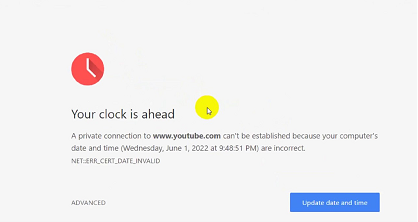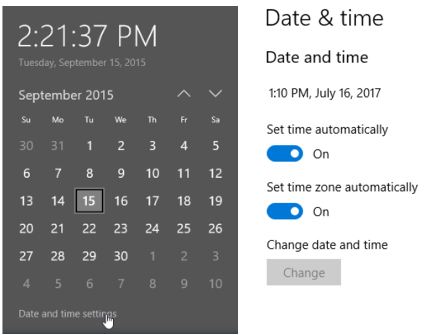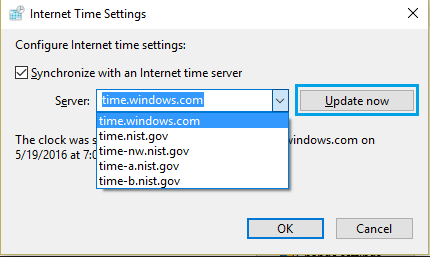Your clock is behind/ahead: Error
When encountering errors like "Your clock is behind," "Your clock is ahead," or "NET::ERR_CERT_DATE_INVALID," it indicates that an SSL error is occurring due to incorrect date and time settings on your computer. To resolve this issue and eliminate the error message, it is essential to update your device's clock to ensure accurate time and date synchronization.

This problem can be fixed in a matter of seconds:
- Click on the date and time on the taskbar.
- After that click on "Date and time settings."
- If you have windows 10 then make "Set time automatically" to "On."

In other Windows operating systems, clicking on the "Date and Time" settings will open a new window. From there, navigate to the "Internet Time" tab.
- Click on the date and time on the taskbar.
- Select the "Internet Time" tab.
- Click on "Change settings" and tick mark on "Synchronize with an Internet time server" and inside server select "time.windows.com" after that click on update now and then OK.

After change the above settings, restart chrome and see if the issue is resolved or not.
Why is Chrome reporting "Your clock is ahead" message?
All web browsers come with a default built-in list of various SSL certificates (secure socket layer). In the SSL process, clocks play a crucial role in certificate validation. Certificates used by secure websites (with URLs beginning with "https://") have a limited validity period. If a website's certificate does not match the current time on your system's clock, browsers cannot verify the connection's security. Any discrepancy in the certificates results in an SSL Connection Error in the browser.
Time synchronization is crucial in preventing replay attacks in secure communication protocols. Without proper time synchronization, an attacker could record packets exchanged between a client and server, decrypt the data, modify it, and then resend the packet stream without detection. However, with the use of timestamps that are validated on both ends, the decryption process takes into account the current time, which can indicate whether the received stream is a potential replay, thus enhancing the security of the communication.
when a client communicates with a server, it needs to ensure that it is connecting to the legitimate and trusted server. To achieve this, the client validates the server's certificate through a process known as certificate validation. This validation involves verifying several aspects of the server's certificate, and two of these aspects are related to clocks:
The server's certificate contains two important fields: "notBefore" and "notAfter." These fields specify the validity period of the certificate, indicating the time range during which the certificate is considered valid.
- notBefore: This field indicates the date and time from which the certificate becomes valid. It sets the earliest time when the certificate can be used for secure communication.
- notAfter: This field indicates the date and time until which the certificate remains valid. It sets the latest time until which the certificate can be used for secure communication.
To establish a secure connection, the current time must fall between the "notBefore" and "notAfter" dates specified in the server's certificate. If the current time is outside this validity time range, the client will consider the certificate expired or not yet active, and the connection will not be established.
In addition to validating the server's certificate for its validity period using the "notBefore" and "notAfter" fields, the client should also obtain and validate a Certificate Revocation List (CRL) from the appropriate issuers. A CRL contains a list of revoked certificates, indicating those certificates that are no longer considered valid before their actual expiration date.
To ensure the CRL's validity, the client checks the "thisUpdate" field, which indicates when the CRL was generated. The client also checks the "nextUpdate" field, which serves as the expiration date for the CRL. The client deems the CRL acceptable if it is not too old, meaning it falls between the "thisUpdate" and "nextUpdate" fields.
Similarly, if the client's clock is significantly off when validating the CRL, the "thisUpdate" and "nextUpdate" fields of the CRL might not align with the actual time. As a result, the client could deem the CRL as too old or not yet active, causing issues in certificate revocation status validation.
Conclusion
It is crucial for the client's clock to be accurately synchronized with the current time to ensure proper functioning of certificate validation mechanisms and maintain the security and trustworthiness of secure communications. Regular time synchronization is essential to prevent such problems and ensure the smooth operation of SSL/TLS protocols and certificate handling.
- How to Print Screen
- How to View Hidden Files in Windows 11, 10, 8 and 7
- Fahrenheit to Celsius Temperatire Conversion Formula
- How to zip files - Compress and uncompress files
- How to Use Robocopy
- How to WMIC ?
- How to recover deleted files
- Microsoft Outlook POP3 Settings, Microsoft Outlook IMAP Settings
- How to Update Windows 11
- What is Three-Tier Architecture ?
- What Is an API (Application Program Interface) ?
- Differences Between HTML4 And HTML5
- How to choose the best antivirus software
- How to Embed a YouTube Video in Your Website
- what is the difference between x64 and x86
- Learn Multiplication of Tables
- What is a Proxy Server?
- How to use a Google Android phone as a Wi-Fi hotspot
- How to automatically redirect a Web Page to another URL
- How to Download YouTube Videos
- What is a Phishing Attack ? How can I avoid them?
- What is a Call To Action?
- What's the Difference Between JPG and PNG?
- What Is a "500 Internal Server Error" and How Do I Fix It?
- What is the difference between OTF and TTF fonts
- How to enable flash player on chrome
- How to Select a Video Editing Software
- Why am I getting a "Your connection is not private error" in Chrome
- How to block "Deceptive site ahead" security error?
- Crypto for beginners: What is cryptocurrency?
- What is Bitcoin and how does it work?
- How to fix HTTP Error 502 Bad gateway
- GET url returns "data:text/html,chromewebdata"
- How to fix ERR_UNKNOWN_URL_SCHEME
- SSL Error on Port 443
- How to Fix This Site Can't Be Reached Error in Chrome
- A disk read error occurred, Press Ctrl+Alt+Del to restart
- How to use System Restore on Windows 10
- What is HTTP error 503 and how do you fix it?
- How to get help in Windows 10
- How To Disable Windows 10 Forced Updates
- How to Fix Google Chrome Error - ERR_SSL_PROTOCOL_ERROR
- How to reset windows 10 password
- What is Blockchain?
- How To Fix: ERR_PROXY_CONNECTION_FAILED
- Unable to send mail through smtp.gmail.com
- How to fix DNS_PROBE_FINISHED_NXDOMAIN
- How to use GTMetrix to Speed up Your Website?
- How to fix System Thread Exception Not Handled Error
- How to fix ERR_INTERNET_DISCONNECTED Error
- WiFi Connected But No Internet Access – How to Fix?
- How to fix a HTTP Error 400: Bad Request?
- What is Deprecation
- How to Fix a 403 Forbidden Error
- What is the maximum length of a URL in different browsers?
- SSL Certificate Problem: Unable to get Local Issuer Certificate
- How to Fix the ERR_CONNECTION_TIMED_OUT Error
- What does localhost:8080 mean?
- How to reduce initial server response time
- 414 Request-URI Too Long - HTTP
- Message channel closed before a response was received